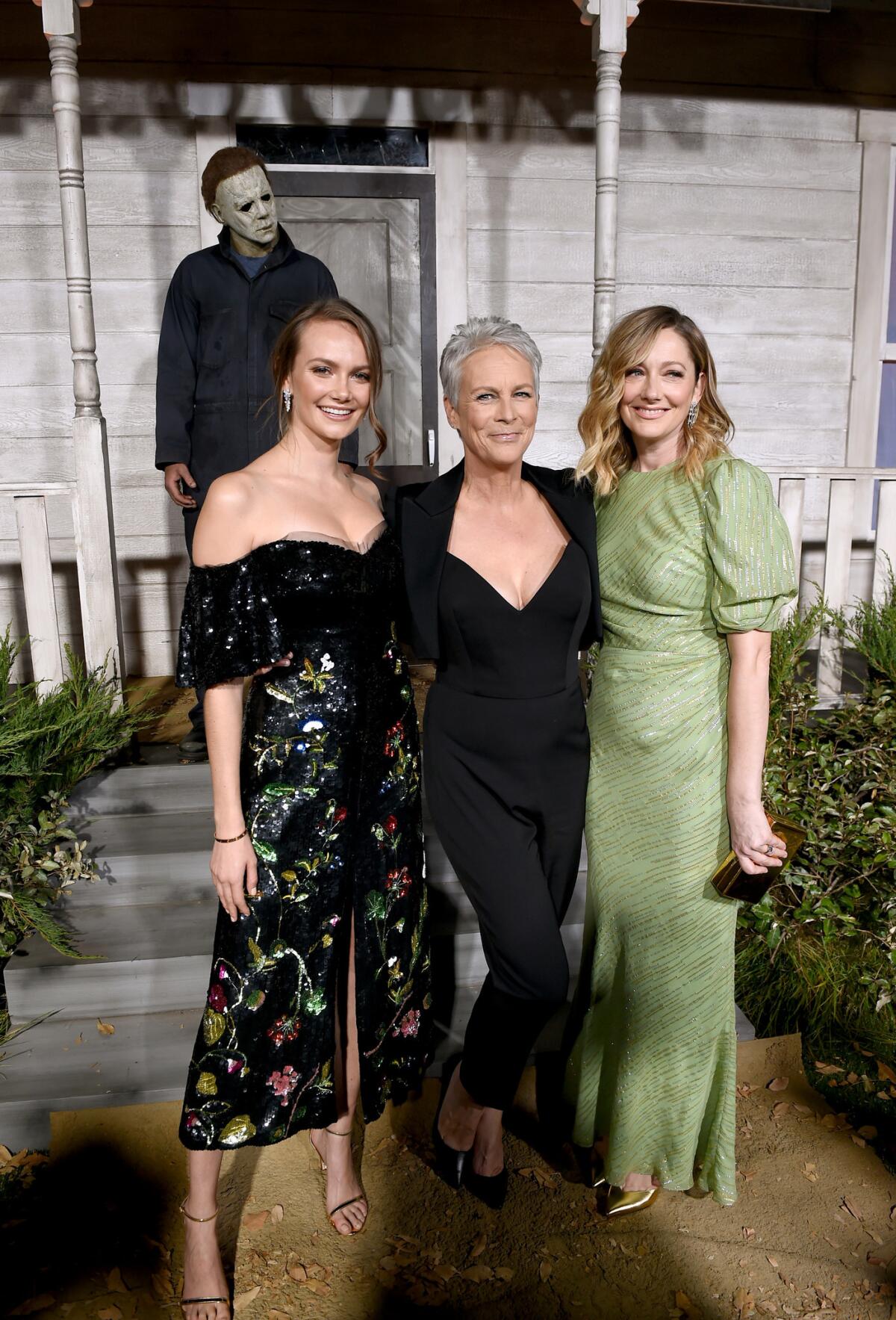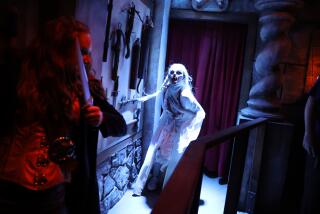Jamie Lee Curtis, Judy Greer and Andi Matichak discuss the ‘powerful’ climax of ‘Halloween’
In 1978, teenage babysitter Laurie Strode survived a showdown with masked serial killer Michael Myers in John Carpenter’s “Halloween,” a critically acclaimed and commercially successful slasher flick that would spawn 11 films and jump-start the career of emerging young actress Jamie Lee Curtis.
Forty years later, Strode and Myers face off again in Universal’s “Halloween” revival. Produced by Blumhouse and Miramax and directed by veteran indie filmmaker David Gordon Green, the film grossed a massive $76.2 million and shattered several box office records when it opened over the weekend.
And it did so by ignoring the 10 sequels and reboots that were released since the original “Halloween,” upending several of the original film’s classic horror tropes in the process.
“The reason why [they’ve] taken away all the other history is to tell a clean story between one point and another,” said Curtis, who has reprised her role for three other “Halloween” sequels over the years. “You can’t do that if you have to touch base on every weird plot twist of 40 years.”
In the new film, Strode is both mentally and emotionally scarred by the events of her adolescence. Traumatized and convinced that Myers will return to finish the job, Strode transforms her secluded home in the woods into a heavily fortified estate.
The lingering trauma has made it impossible for her to maintain healthy relationships, exemplified by two failed marriages and an estranged relationship with her daughter, Karen (Judy Greer), and granddaughter, Allyson (Andi Matichak).
“A family story is the way to tell the ‘Halloween’ story because of the trauma that gets passed from one family member to the next,” said Curtis. “What happens to someone when you attack them and they survive is that the rest of their life is branded by that violence.”
The relatability of the characters and their relationships are what elevate this film from slasher traditions, says Gordon Green.
“I’m convinced that what makes a horror film like this stand out, as opposed to just a supernatural cacophony of grotesqueness, is there’s emotional substance that we can relate to,” he told The Times by phone shortly before opening day.
“It’s what drew me to Carpenter’s film in the first place. I may not have lived in Haddonfield, Ill., in 1978, but these characters, these situations, this environment feel familiar to me.”
It’s infinitely more interesting to watch Jamie Lee Curtis kick all the ass. Forty years later, it is her story.”
— Judy Greer
In direct contrast to Carpenter’s film, which was shot largely from Myers’ point of view, one of the most refreshing updates in the new film is its utilization of the female gaze, a rarely explored perspective in slasher movies.
“The [original] movie is told through the male gaze because it was [Myers’] gaze and his obsession that the movie was focused on,” said Curtis. “This movie is told through the female gaze because it’s a woman’s obsession.”
Though the decision makes logistical sense, it also modernizes an often misogynistic genre for the #MeToo era.
“I think what’s in the zeitgeist right now with more female empowerment, it’s just a more interesting story to tell,” said Greer. “The idea of a woman facing her traumas and her fears and becoming a badass, and then seeing two generations of women following in her footsteps, I think is what the fans would want too.
“It’s infinitely more interesting to watch Jamie Lee Curtis kick all the ass. Forty years later, it is her story.”
Review: A nasty, nimble ‘Halloween’ sequel finds this horror franchise in pretty good shape »
For Gordon Green, focusing on the female perspective was an easy choice. Citing the praise Carpenter’s original received for an “intelligent and interesting female lead character” in a genre usually short on both traits, he said the creative team knew instinctively: “Let’s double down, triple down on that.” But the decision also forced him to seek guidance.
“I could never rid myself of the male gaze, unfortunately,” he said. “So as writers, Danny [McBride] and Jeff Bradley and myself bring our architecture of what we think would be fun as viewers. And dispelling [the trope of] the final girl, the scream queen, empowering female characters — we can only do that to such a degree because of our genetics.”
His solution? Cast “powerhouses” in the lead roles and invite them into the creative conversations.
“You engage as a reactive director as much as an active director,” he said. “So that you can make it honest and emotional and take it to a place that the architecture wasn’t going to do.”
Matichak, whose role in the new “Halloween” is in many ways the closest to Curtis’ Strode of 40 years ago, appreciated how natural the process felt.
“I think something that David and Danny and Jeff do really well is that they respect women as humans, and that just translates into their writing,” said Matichak. “It wasn’t so much as making a point that they’re women, as it’s making a point that they just so happen to be women.”
But the decision to unite three generations of Strode women in a single narrative pays its biggest dividends in the film’s climax — a thrilling and cathartic sequence that was both poignant and physically taxing for all of the actors involved.
Warning: Spoilers to follow
After Myers has once again rampaged through Haddonfield, he makes his way to Laurie’s house, and a game of cat and mouse ensues, as they take turns stalking each other through a series of carefully booby-trapped rooms. With 40 years of prep time, Laurie has armed her house with a hidden basement, drop-down gates in every doorway and an impressive artillery of pistols and shotguns.
There’s an inversion of several key scenes from the original film in which Myers stalked Strode (including the balcony fake-out), before Myers is overpowered by the combined forces of the three women and captured in the basement safe room.
“You think that because of the trauma [Laurie’s] been in that she lives in a gated prison, the very same thing we saw [Myers] in in the beginning of the movie,” said Curtis. “It looks like she’s replicated even that part of his life, but then, of course, it wasn’t.”
Though the sequence, which sees Michael battling each of the Strode women individually and collectively, is ultimately won by the protagonists, shooting it took a heavy physical toll on the stars.
“You know that the end of the movie is going to involve a lot of violence,” said Curtis. “It’s where everybody gets hurt literally because the stakes and the physicality of it and the violence level is so high. Of course that’s where I cracked a rib, that’s where Judy got the ... kicked out of her.”
“She and I could’ve had a bruise-off,” said Greer. “The next day I woke up and looked at my legs in my hotel room, and I was like, ‘Oh, my God, I look like I’ve been hit by a car.’”
In one of the film’s most memorable moments, Karen, who resents her mother for the military-style training she was forced to undergo as a kid, grabs a shotgun inscribed with her initials and a lightning bolt in a childlike handwriting. (“Lightning bolts are cool,” Greer notes.)
But it’s the youngest Strode who ultimately deals the final blow, stabbing Myers with the same kitchen knife he stalks his victims with.
“It was extremely powerful,” said Matichak of filming the scene. “I felt so emotional on the day of because of the gravity of what it was. The final shot of the film where the three of us are all together in the back of the truck — that is kind of when everything hit me ... what we’d just accomplished.”
“The youngest one … she’s the one who saved their family with a knife,” said Curtis. “And that it ends on her with the knife is a way to say that the family has been brought together — through blood, sweat and tears.
“How you end the movie is always very tricky because we knew that Michael had split apart the family. That was what we told the story as, that trauma splits apart a family. So we knew we had to bring the family back together.”
“I think there’s a hope that we can put all of this behind us,” said Matichak, “and that these three women can try to just rebuild our lives in a way that is a little bit healthier than how it went down for Laurie for the last 40 years.”

Curtis says never in a million years could she have predicted she’d get the call to return to “Halloween,” insisting she’d never given much thought to returning to the genre or the franchise.
“It’s not like I wanted to be back in the genre or wanted to be back in a ‘Halloween’ movie,” she said. “Each time, there’s been a very big emotional reason to do it. The first one, I was so overwhelmed to have such a big, important role … it was my first role in a movie. And it sort of branded my life in a way.”
“She has such ownership over [the franchise], and I don’t necessarily mean literally, but it’s in her bones and in her DNA,” said Greer. “It was a real honor to be a part of it and to go through this process with her. It’s different than just working with an actor where we’re all just cast and we’re playing these roles and we’re all sort of creating them together.”
“I really don’t have the words to explain it,” agreed Matichak of working with Curtis. “‘Halloween’ is her home, so it was her set, and she owned it. It was incredible to get to watch her go through this again 40 years later. And not only watch her go through it but to get to go along for the ride.”
Times staff writer Mark Olsen contributed to this report.
follow me on twitter @sonaiyak
More to Read
Only good movies
Get the Indie Focus newsletter, Mark Olsen's weekly guide to the world of cinema.
You may occasionally receive promotional content from the Los Angeles Times.









